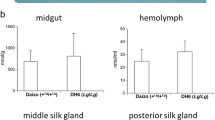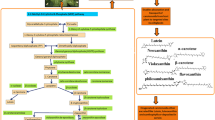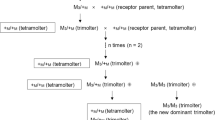Abstract
THE mutant lemon of the silkworm is characteristically yellow in colour, accumulating a fluorescent pigment, xanthopterin-B1, in the skin. Extract of the fat body of the wild-type silkworm converts this pigment into a non fluorescent product1. There is some evidence to support the view that xanthopterin-B1 is identical with sepiapterin2, which is known to be reduced, in the presence of reduced nicotinamide dinucleotide phosphate (NADPH), by a folate reductase from chicken liver and Drosophila3,4.
Similar content being viewed by others
References
Aruga, H., Kawase, S., and Akino, M., Experientia, 10, 336 (1954).
Nawa, S., and Taira, T., Proc. Jap. Acad., 30, 632 (1954).
Taira, T., Nature, 189, 231 (1961).
Taira, T., Jap. J. Genet., 36, 244 (1961).
Akino, M., and Tsusue, M. (unpublished work).
Zakrzewski, S. F., J. Biol. Chem., 235, 1776 (1960).
Lowry, O. H., Rosebrough, N. J., Farr, A. L., and Randall, R. J., J. Biol. Chem., 193, 265 (1951).
Author information
Authors and Affiliations
Rights and permissions
About this article
Cite this article
MATSUBARA, M., TSUSUE, M. & AKINO, M. Occurrence of Two Different Enzymes in the Silkworm, Bombyx mori, to reduce Folate and Sepiapterin. Nature 199, 908–909 (1963). https://doi.org/10.1038/199908a0
Issue Date:
DOI: https://doi.org/10.1038/199908a0
- Springer Nature Limited
This article is cited by
-
Partial purification and some properties of biopterin synthase and dihydropterin oxidase from Drosophila melanogaster
Biochemical Genetics (1979)
-
Occurrence of sepiapterin deaminase in the silkworm,Bombyx mori
Experientia (1967)
-
Pterine als Wirkstoffe und Pigmente
Ergebnisse der Physiologie Biologischen Chemie und Experimentellen Pharmakologie (1965)
-
On the presence of sepiapterin reductase different from folate and dihydrofolate reductase in chicken liver
Experientia (1964)





